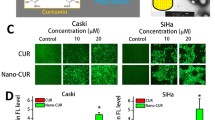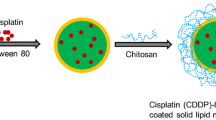Abstract
Nowadays plant origin compounds with anti-cancer properties come into prominence, among them is curcumin (CUR) with a remarkable anti-cancer activity against various cancers. CUR was nanoformulated (CUR-PLGA) by the polymer based poly(lactic-co-glycolic acid) (PLGA) and both CUR and CUR-PLGA were radiolabeled with iodine-131 radionuclide for investigation of their in vitro behaviour on Human cervix adenocarcinoma (HeLa) and Ovarian endometrioid adenocarcinoma (MDAH-2774) cell lines. The newly described radiolabeled CUR and CUR-PLGA may be initiative discovery of novel potential imaging and therapeutic agents.





Similar content being viewed by others
References
Ghasemi F, Shafiee M, Banikazemi Z et al (2019) Curcumin inhibits NF-kB and Wnt/β-catenin pathways in cervical cancer cells. Pathol Res Pract 215:1–6
Lin YG, Kunnumakkara AB, Nair A et al (2007) Curcumin ınhibits tumor growth and angiogenesis in ovarian carcinoma by targeting the nuclear factor-B pathway. Clin Cancer Res 13:3423–3430
Pathak K, Akhtar N (2018) Nanocarriers for the effective treatment of cervical cancer: research advancements and patent analysis. Recent Pat Drug Deliv Formul 12:93–109
Efferth T, Saeed MEM, Mirghani E et al (2017) Integration of phytochemicals and phytotherapy into cancer precision medicine. Oncotarget 8:50284–50304
Alibolandi M, Hoseini F, Mohammadi M et al (2018) Curcumin-entrapped MUC-1 aptamer targeted dendrimer-gold hybrid nanostructure as a theranostic system for colon adenocarcinoma. Int J Pharm 549:67–75
Park BH, Lim JE, Jeon HG et al (2016) Curcumin potentiates antitumor activity of cisplatin in bladder cancer cell lines via ROS-mediated activation of ERK1/2. Oncotarget 7:63870–63886
Adiwidjaja J, McLachlan AJ, Boddy AV (2017) Curcumin as a clinically-promising anti-cancer agent: pharmacokinetics and drug interactions. Expert Opin Drug Metab Toxicol 13:953–972
Aggarwal B, Kumar A, Bharti A (2003) Anticancer potential of curcumin: preclinical and clinical studies. Anticancer Res 23:363–398
Biber Muftuler FZ, Yurt Kilcar A, Unak P (2015) A perspective on plant origin radiolabeled compounds, their biological affinities and interaction between plant extracts with radiopharmaceuticals. J Radioanal Nucl Chem 306:1–9
Vitaglione P, Barone Lumaga R, Ferracane R et al (2012) Curcumin bioavailability from enriched bread: the effect of microencapsulated ıngredients. J Agric Food Chem 60:3357–3366
Shen L, Liu C-C, An C-Y, Ji H-F (2016) How does curcumin work with poor bioavailability? Clues from experimental and theoretical studies. Sci Rep 6:20872
Suo A, Qian J, Xu M et al (2017) Folate-decorated PEGylated triblock copolymer as a pH/reduction dual-responsive nanovehicle for targeted intracellular co-delivery of doxorubicin and Bcl-2 siRNA. Mater Sci Eng C 76:659–672
Feng T, Wei Y, Lee RJ, Zhao L (2017) Liposomal curcumin and its application in cancer. Int J Nanomed 12:6027–6044
Zhang H, Zhang Y, Chen Y et al (2018) Glutathione-responsive self-delivery nanoparticles assembled by curcumin dimer for enhanced intracellular drug delivery. Int J Pharm 549:230–238
Wang L, Xu X, Zhang Y et al (2013) Encapsulation of curcumin within poly(amidoamine) dendrimers for delivery to cancer cells. J Mater Sci Mater Med 24:2137–2144
Sun M, Su X, Ding B et al (2012) Advances in nanotechnology-based delivery systems for curcumin. Nanomedicine 7:1085–1100
McCarron PA, Hall M (2004) Pharmaceutical nanotechnology. Encycl Nanosci Nanotechnol 8:469–487
Mérian J, Gravier J, Navarro F, Texier I (2012) Fluorescent nanoprobes dedicated to in vivo imaging: from preclinical validations to clinical translation. Molecules 17:5564–5591
Saha GB (2018) Fundamentals of nuclear pharmacy, 7 edn. Springer. https://doi.org/10.1007/978-3-319-57580-3
Blankenberg FG, Strauss HW (2002) Nuclear medicine applications in molecular imaging. J Magn Reson Imaging 16:352–361
Huang C, Chen F, Zhang L et al (2020) 99mTc radiolabeled HA/TPGS-based curcumin-loaded nanoparticle for breast cancer synergistic theranostics: design, in vitro and in vivo evaluation. Int J Nanomed 15:2987–2998
Mukerjee A, Vishwanatha JK (2009) Formulation, characterization and evaluation of curcumin-loaded PLGA nanospheres for cancer therapy. Anticancer Res 29:3867–3875
Luz PP, Magalhães LG, Pereira AC et al (2012) Curcumin-loaded into PLGA nanoparticles. Parasitol Res 110:593–598
Punfa W, Yodkeeree S, Pitchakarn P et al (2012) Enhancement of cellular uptake and cytotoxicity of curcumin-loaded PLGA nanoparticles by conjugation with anti-P-glycoprotein in drug resistance cancer cells. Acta Pharmacol Sin 33:823–831
Yallapu MM, Gupta BK, Jaggi M, Chauhan SC (2010) Fabrication of curcumin encapsulated PLGA nanoparticles for improved therapeutic effects in metastatic cancer cells. J Colloid Interface Sci 351:19–29
Yallapu MM, Maher DM, Sundram V et al (2010) Curcumin induces chemo/radio-sensitization in ovarian cancer cells and curcumin nanoparticles inhibit ovarian cancer cell growth. J Ovarian Res 3:11
Zaman MS, Chauhan N, Yallapu MM et al (2016) Curcumin nanoformulation for cervical cancer treatment. Sci Rep 6:1–14
Ganta S, Amiji M (2009) Coadministration of paclitaxel and curcumin in nanoemulsion formulations to overcome multidrug resistance in tumor cells. Mol Pharm 6:928–939
Luong D, Kesharwani P, Alsaab HO et al (2017) Folic acid conjugated polymeric micelles loaded with a curcumin difluorinated analog for targeting cervical and ovarian cancers. Colloids Surf B Biointerfaces 157:490–502
Ayan AK, Yenilmez A, Eroglu H (2017) Evaluation of radiolabeled curcumin-loaded solid lipid nanoparticles usage as an imaging agent in liver-spleen scintigraphy. Mater Sci Eng C Mater Biol Appl 75:663–670
Singh UV, Bisht KS, Rao S et al (1996) Plumbagin-loaded PLGA microspheres with reduced toxicity and enhanced antitumour efficacy in mice. Pharm Pharmacol Commun 2:407–440
Yildiz G, Yurt Kilcar A, Medine EI et al (2017) PLGA encapsulation and radioiodination of indole-3-carbinol: investigation of anticancerogenic effects against MCF7, Caco2 and PC3 cells by in vitro assays. J Radioanal Nucl Chem 311:1043–1052
Dervis E, Yurt Kilcar A, Medine EI et al (2017) In vitro ıncorporation of radioiodinated eugenol on adenocarcinoma cell lines (Caco2, MCF7, and PC3). Cancer Biother Radiopharm 32(3):1–7
Karatay KB, Kılçar AY, Derviş E, Müftüler FZB (2020) Radioiodinated ginger compounds (6-gingerol and 6-shogaol) and ıncorporation assays on breast cancer cells. Anticancer Agents Med Chem 20:1129–1139
Kumar C, Subramanian S, Samuel G (2016) Evaluation of radioiodinated curcumin for its potential as a tumor-targeting radiopharmaceutical. J Radiat Cancer Res 7:112
Brannon-Peppas L (1995) Recent advances on the use of biodegradable microparticles and nanoparticles in controlled drug delivery. Int J Pharm 116:1–9
Peltonen L, Koistinen P, Karjalainen M et al (2002) The effect of cosolvents on the formulation of nanoparticles from low-molecular-weight poly(l)lactide. AAPS PharmSciTech 3:E32
Yurt Kilcar A, Tekin V, Biber Muftuler FZ, Medine EI (2016) 99mTc labeled plumbagin: estrogen receptor dependent examination against breast cancer cells and comparison with PLGA encapsulated form. J Radioanal Nucl Chem 308:13–22
Acknowledgements
Current work is supported by Ege University Scientific Research Projects Coordination (Contract No. 2017 TIP 044). The authors thank to Öykü Madenci, Fatmagül Gedik and Neşe Kavçar for the technical assistance during the assays.
Author information
Authors and Affiliations
Corresponding author
Additional information
Publisher's Note
Springer Nature remains neutral with regard to jurisdictional claims in published maps and institutional affiliations.
Rights and permissions
About this article
Cite this article
Gokulu, S.G., Yurt Kilcar, A., Bilgi, A. et al. Investigation of nanoformulation and incorporation potential of radiolabeled curcumin using HeLa and MDAH-2774 cells. J Radioanal Nucl Chem 327, 299–305 (2021). https://doi.org/10.1007/s10967-020-07509-7
Received:
Accepted:
Published:
Issue Date:
DOI: https://doi.org/10.1007/s10967-020-07509-7




